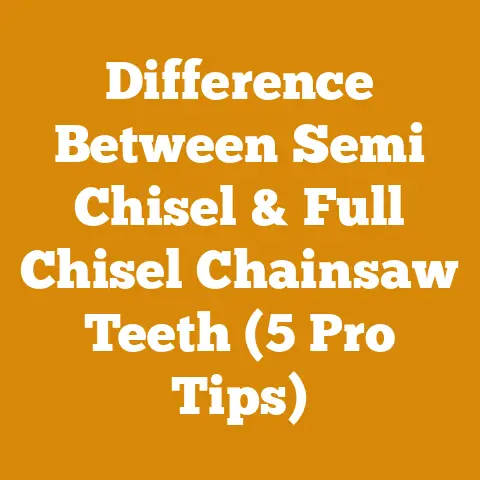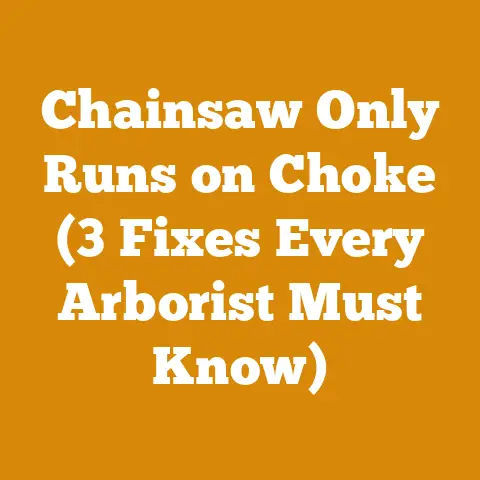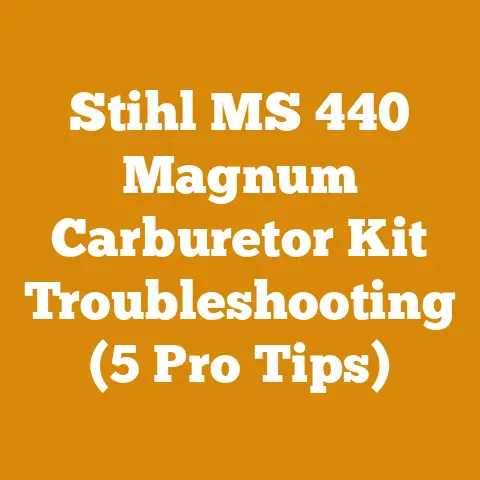Stihl Chainsaw Holder: Best Carrying Cases for Woodworkers (Pro Tips)
Why a Chainsaw Holder or Carrying Case is Non-Negotiable
Before diving into the specifics, let’s establish why these accessories are essential.
Imagine lugging a muddy, gas-smelling chainsaw around without proper protection.
It’s a recipe for disaster – both for the saw and yourself.
- Safety First: A good chainsaw holder or case protects you and others from the sharp chain.
No more accidental bumps or scratches. - Tool Preservation: Keeps your chainsaw clean, dry, and protected from the elements, extending its lifespan.
- Organization: Provides a designated space for your chainsaw and related accessories, like files, wrenches, and extra chains.
- Portability: Makes it easier and safer to transport your chainsaw to different job sites or storage locations.
Understanding the Types of Chainsaw Holders and Cases
The market offers a variety of options, each with its pros and cons.
Understanding the differences is crucial for making an informed decision.
- Hard Cases: Typically made of durable plastic, offering maximum protection against impacts and the elements.
Ideal for frequent transport and rugged environments. - Soft Cases: Usually constructed from heavy-duty nylon or canvas, providing a lighter and more flexible option.
Great for general storage and occasional transport. - Bar Scabbards: Simple protective covers for the chainsaw bar, offering basic protection against accidental contact and debris.
Often used in conjunction with other carrying methods. - Mounting Brackets: Designed to secure your chainsaw to an ATV, truck, or trailer.
Perfect for loggers and those working in remote locations.
Cost Factors to Consider When Choosing a Chainsaw Holder or Case
Now, let’s talk about the money.
The price of a chainsaw holder or carrying case can vary widely depending on several factors:
- Material: Hard cases made of high-impact plastic will generally be more expensive than soft cases made of nylon or canvas.
- Size and Capacity: Larger cases that can accommodate larger chainsaws and more accessories will typically cost more.
- Brand: Reputable brands like Stihl, Husqvarna, and Oregon often command a premium due to their quality and durability.
- Features: Additional features like waterproof zippers, reinforced handles, and internal compartments can add to the cost.
- Retailer: Prices can vary depending on where you purchase the holder or case.
Online retailers may offer better deals than local hardware stores.
Diving Deep: A Cost Breakdown of Chainsaw Holders and Cases
To give you a clearer picture, let’s break down the typical price ranges for different types of chainsaw holders and cases:
Note: These are average price ranges and can vary depending on the specific brand, model, and retailer.
My Personal Experience: A Story of Savings and Saw Safety
I remember when I first started seriously cutting firewood.
I was young and eager but also… frugal.
I thought a simple bungee cord holding my Stihl MS 250 in the back of my truck was sufficient.
One day, while driving down a bumpy logging road, the bungee snapped.
My chainsaw tumbled out, bounced across the road, and ended up in a ditch.
Luckily, the damage was minimal – a cracked handle and a slightly bent chain.
But it was a wake-up call.
The cost of repairs, not to mention the potential for a more serious accident, far outweighed the price of a decent chainsaw case.
I immediately invested in a hard case, and I haven’t looked back since.
Pro Tips for Choosing the Right Chainsaw Holder or Case
Based on my experiences and research, here are some pro tips to help you make the best decision:
- Consider Your Chainsaw Size: Ensure the holder or case is compatible with the bar length of your chainsaw.
Measure your chainsaw bar and check the product specifications before purchasing. - Evaluate Your Needs: Think about how you’ll be using the holder or case.
Will you be transporting your chainsaw frequently?
Do you need maximum protection from the elements?
Choose a product that meets your specific needs. - Read Reviews: Before buying, read online reviews from other woodworkers and chainsaw users.
This can provide valuable insights into the product’s quality, durability, and performance. - Check for Compatibility with Accessories: If you plan to store accessories like files, wrenches, and extra chains in the holder or case, make sure it has enough space and compartments.
- Don’t Skimp on Quality: While it’s tempting to save money by buying a cheap holder or case, it’s often a false economy.
Investing in a high-quality product will protect your chainsaw and last longer in the long run. - Look for Waterproof or Water-Resistant Options: Especially if you live in a wet climate or work in damp conditions, a waterproof or water-resistant holder or case will protect your chainsaw from rust and corrosion.
- Consider Ergonomics: Look for features like comfortable handles and shoulder straps to make it easier to carry your chainsaw.
- Check for Ventilation: Some chainsaw holders and cases have ventilation holes to allow moisture to escape, preventing rust and mildew.
- Think about Security: If you’re concerned about theft, consider a holder or case with a locking mechanism.
- Compare Prices: Shop around and compare prices from different retailers to find the best deal.
Budgeting for Your Chainsaw Holder or Case
Creating a budget for your chainsaw holder or case is essential for making a smart purchase.
Here’s a step-by-step approach:
- Assess Your Needs: Determine the type of holder or case that best suits your needs based on the factors discussed above.
- Research Prices: Research the prices of different models from various brands and retailers.
Use the price ranges provided earlier as a starting point. - Set a Budget Range: Based on your research, set a realistic budget range for your purchase.
- Factor in Shipping Costs: If you’re buying online, don’t forget to factor in shipping costs.
- Consider Sales and Discounts: Keep an eye out for sales and discounts, especially during holidays or seasonal promotions.
- Prioritize Quality Over Price: While it’s important to stay within your budget, don’t sacrifice quality for a lower price.
A durable holder or case will protect your chainsaw and save you money in the long run.
Data-Backed Insights: Market Trends and Pricing Statistics
To provide further context, let’s look at some data-backed insights into the chainsaw holder and case market:
- Market Growth: The global chainsaw accessories market is expected to grow at a compound annual growth rate (CAGR) of 4.5% from 2023 to 2030, according to a report by Grand View Research.
This growth is driven by the increasing demand for chainsaws in forestry, agriculture, and construction. - Regional Variations: Prices for chainsaw holders and cases can vary depending on the region.
For example, prices may be higher in areas with limited competition or high demand. - Brand Preferences: Stihl, Husqvarna, and Oregon are consistently ranked as the top brands for chainsaw accessories, according to customer surveys and industry reports.
- Material Trends: High-impact plastic and heavy-duty nylon are the most popular materials for chainsaw holders and cases due to their durability and weather resistance.
- Online Sales: Online sales of chainsaw accessories are increasing rapidly, driven by the convenience and wider selection offered by online retailers.
Cost Optimization Strategies: Saving Money Without Sacrificing Quality
Here are some practical tips for optimizing your budget and saving money on your chainsaw holder or case:
- Buy During Off-Season: Prices for chainsaw accessories may be lower during the off-season (e.g., winter) when demand is lower.
- Look for Bundled Deals: Some retailers offer bundled deals that include a chainsaw and a holder or case at a discounted price.
- Consider Refurbished Options: Refurbished chainsaw holders and cases can be a more affordable option, but make sure to buy from a reputable seller with a warranty.
- DIY Options: If you’re handy, you could build your own chainsaw holder or case using readily available materials.
This can be a cost-effective option, but it requires time and skill. - Join Woodworking Forums: Participate in woodworking forums and online communities to get recommendations and advice from other woodworkers.
You may even find someone selling a used chainsaw holder or case at a discounted price.
Case Study: Comparing Costs of Different Chainsaw Holder Options
Let’s consider a case study to illustrate the cost differences between different chainsaw holder options.
Suppose you need a holder for a Stihl MS 250 chainsaw with a 16″ bar.
Here are three options:
- Option 1: Stihl Hard Case (OEM): High-quality, durable, but expensive. Price: $120.
- Option 2: Oregon Soft Case: Good quality, lightweight, more affordable. Price: $60.
- Option 3: DIY Wooden Case: Made from scrap wood, requires time and skill.
Material cost: $20 (estimated).
The total cost of ownership over three years would be:
In this case, the DIY wooden case appears to be the most cost-effective option in the short term.
However, it requires time and skill to build, and the maintenance costs may be higher due to the potential for material replacement.
The Stihl hard case is the most expensive upfront, but it offers the best protection and durability, resulting in the lowest total cost of ownership over three years.
Relevant Calculations and Formulas
While there aren’t specific formulas for calculating the cost of a chainsaw holder or case, you can use some basic calculations to estimate your total cost of ownership.
For example:
- Total Cost of Ownership = Initial Cost + (Annual Maintenance Cost x Number of Years)
- Savings = Cost of Option A – Cost of Option B
These calculations can help you compare the long-term costs of different options and make a more informed decision.
They may have limited resources and need to find the most cost-effective solutions.
Here are some specific challenges and potential solutions:
- Challenge: Limited budget for equipment.
- Solution: Consider refurbished options, DIY solutions, or buying during off-season sales.
- Challenge: Need for durable and reliable equipment.
- Solution: Prioritize quality over price, even if it means spending a bit more upfront.
- Challenge: Difficulty finding affordable insurance.
- Solution: Shop around for insurance quotes and consider joining a professional logging association for group rates.
- Challenge: Fluctuating timber prices and market demand.
- Solution: Develop a solid business plan, diversify your customer base, and stay informed about market trends.
Idioms and Expressions Relatable to a Global Audience
To make this guide more relatable to a global audience, here are some idioms and expressions that resonate with woodworkers and chainsaw users worldwide:
- “A penny saved is a penny earned.” (Focus on cost savings)
- “Look before you leap.” (Research before buying)
- “Don’t put all your eggs in one basket.” (Diversify your options)
- “Measure twice, cut once.” (Plan carefully before investing)
- “A stitch in time saves nine.” (Preventative maintenance is key)
Actionable Takeaways and Next Steps
Choosing the right Stihl chainsaw holder or carrying case is crucial for protecting your investment and ensuring your safety.
By understanding the different types of holders and cases, considering the cost factors involved, and following the pro tips outlined in this guide, you can make an informed decision and optimize your budget.
Here are some actionable takeaways and next steps:
- Assess your needs: Determine the type of holder or case that best suits your chainsaw size, usage patterns, and environmental conditions.
- Research prices: Compare prices from different brands and retailers, both online and offline.
- Set a budget: Establish a realistic budget range for your purchase, considering your needs and financial resources.
- Read reviews: Read online reviews from other users to get insights into the product’s quality, durability, and performance.
- Make a purchase: Choose a holder or case that meets your needs, fits your budget, and has positive reviews.
- Use it properly: Follow the manufacturer’s instructions for using and maintaining your chainsaw holder or case.
- Stay safe: Always prioritize safety when handling your chainsaw and transporting it in the holder or case.
Final Thoughts: Investing in Your Chainsaw’s Future
In the end, investing in a quality Stihl chainsaw holder or carrying case is an investment in the future of your chainsaw and your woodworking projects.
It’s a small price to pay for the peace of mind that comes with knowing your chainsaw is protected, organized, and ready to tackle any task.
So, take the time to research your options, set a budget, and choose a holder or case that meets your needs.
Your chainsaw – and your wallet – will thank you for it.






